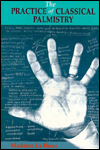The Practice of Classical Palmistry
One of the best introductions to classical palmistry ever! Teaches you how to read the palm and fingers and focuses on the lines as singular expressions of the personality before the palm as a whole is integrated into a reading. The author discusses howto do a reading and work with clients, and provides case studies. Selfstudy questions are given to allow the student to examine his or her own hand in terms of the material in each chapter. Illustrations.
1000085405
The Practice of Classical Palmistry
One of the best introductions to classical palmistry ever! Teaches you how to read the palm and fingers and focuses on the lines as singular expressions of the personality before the palm as a whole is integrated into a reading. The author discusses howto do a reading and work with clients, and provides case studies. Selfstudy questions are given to allow the student to examine his or her own hand in terms of the material in each chapter. Illustrations.
21.95
In Stock
5
1

The Practice of Classical Palmistry
288
The Practice of Classical Palmistry
288
21.95
In Stock

Product Details
| ISBN-13: | 9780877287209 |
|---|---|
| Publisher: | Red Wheel/Weiser |
| Publication date: | 01/15/1993 |
| Pages: | 288 |
| Product dimensions: | 6.00(w) x 9.00(h) x 0.84(d) |
From the B&N Reads Blog
